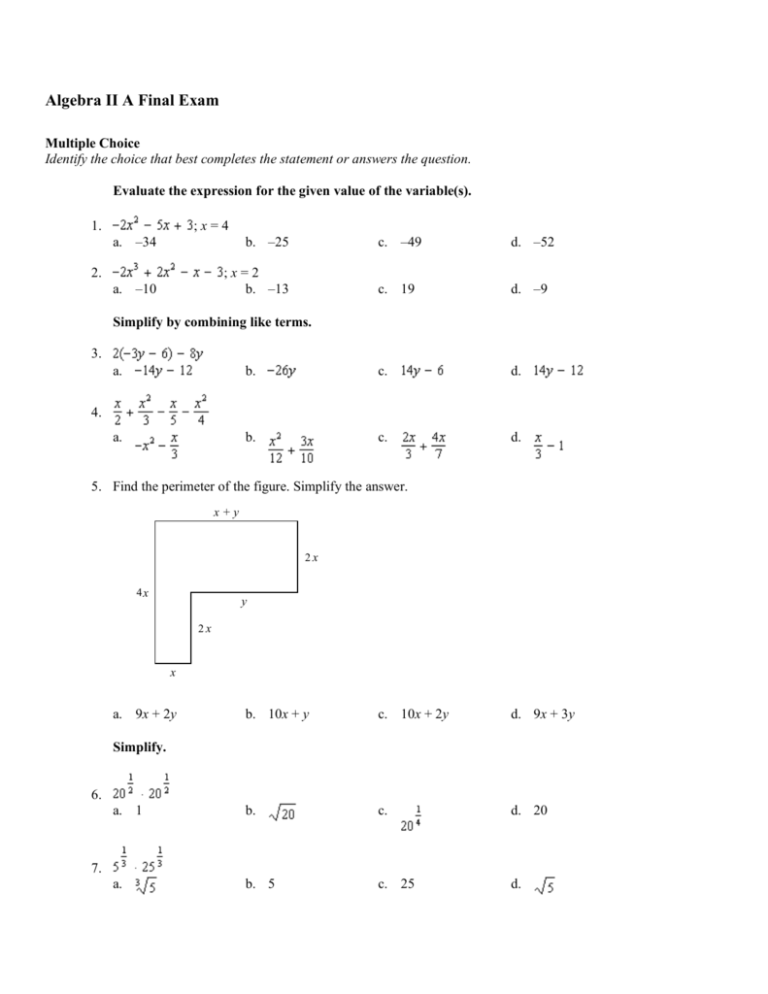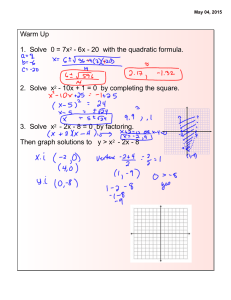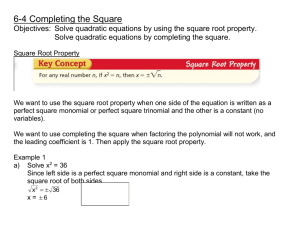Algebra II A Final Exam
advertisement

Algebra II A Final Exam
Multiple Choice
Identify the choice that best completes the statement or answers the question.
Evaluate the expression for the given value of the variable(s).
1.
;x=4
a. –34
b. –25
a. –10
;x=2
b. –13
2.
c. –49
d. –52
c. 19
d. –9
Simplify by combining like terms.
3.
a.
b.
c.
d.
a.
b.
c.
d.
4.
5. Find the perimeter of the figure. Simplify the answer.
x+y
2x
4x
y
2x
x
a. 9x + 2y
b. 10x + y
c. 10x + 2y
d. 9x + 3y
a. 1
b.
c.
d. 20
a.
b. 5
c. 25
d.
Simplify.
6.
7.
8.
a. 512
b. 4
c. 64
d.
Determine whether the function is linear or quadratic. Identify the quadratic, linear, and constant
terms.
9.
a. quadratic function
quadratic term:
linear term:
constant term: 12
b. linear function
linear term:
constant term: 12
c. linear function
linear term:
constant term: 24
a. linear function
linear term:
constant term: –30
b. quadratic function
quadratic term:
linear term:
constant term: –30
c. linear function
linear term:
constant term: –30
d. quadratic function
quadratic term:
linear term:
constant term: –30
d. quadratic function
quadratic term:
linear term:
constant term: 24
10.
11. Classify –3x5 – 2x3 by degree and by number of terms.
a. quintic binomial
c. quintic trinomial
b. quartic binomial
d. quartic trinomial
12. Classify –2x5 + 6x4 – x2 + 8 by degree and by number of terms.
a. cubic binomial
c. quintic polynomial of 4 terms
b. quartic polynomial of 4 terms
d. quadratic binomial
13. Zach wrote the formula w(w – 1)(4w + 3) for the volume of a rectangular prism he is designing, with width w,
which is always has a positive value greater than 1. Find the product and then classify this polynomial by
degree and by number of terms.
a.
; quintic trinomial
b.
; quartic trinomial
c.
; cubic trinomial
d.
; quadratic monomial
14. Write the polynomial
a.
b.
in standard form.
c.
d.
15. Write 2x2(–3x2 + 3x3) in standard form. Then classify it by degree and number of terms.
a. 6x5 – 9x4; quartic binomial
c. 6x5 – 6x4; quintic binomial
4
b. –x + 5x ; quintic binomial
d. –x5 – 6x4; quintic trinomial
16. Write the expression (x + 2)(x + 4) as a polynomial in standard form.
a. x2 – 2x + 2
c. x2 – 2x + 8
2
b. x + 6x + 8
d. x2 + 2x + 6
Use Pascal’s Triangle to expand the binomial.
17.
a.
b.
c.
d.
Factor the expression.
18.
a.
b.
c.
d.
19. Write 2x3 + 0x2 – 50x in factored form.
a. 2x(x – 5)(x + 5)
b. 5x(x + 2)(x – 5)
c. –5x(x + 5)(x + 2)
d. 2x(x + 5)(x + 5)
20. Divide
a.
b.
c.
d.
by x – 4.
, R –170
21. Determine which binomial is not a factor of
a. x + 4
b. x + 3
22. Determine which binomial is a factor of
a. x – 5
b. x + 15
, R 166
.
c. x – 5
d. 4x + 3
.
c. x + 13
d. x + 5
c.
d.
Solve the equation.
23.
a.
b. 3
1
3
−1
1
3
24.
a.
b.
x = 2 or x = 1
x= 1
1
3
1
or x = −2
3
c. x = 2 or x = −2
d. x = 2 or x = 4
−
3
4
25.
a.
c.
1
1
or x = −
3
2
b.
1
x = − or x = −3
3
1
1
or x = −2
2
2
d.
1
x=
or x = −3
2
x=
x=
Solve the equation or formula for the indicated variable.
26.
, for t
a.
27.
b.
c.
d.
b.
c.
d.
.
b. –11
c. 13
d. 11
c. 2
d.
−1
d.
5
4
, for U
a.
28. For
a. –1
,
29. Suppose
Find the value of
a. −2
and
.
.
b.
−3
1
7
Find the slope of the line.
30.
a.
−
4
5
b.
4
5
c.
−
5
4
31.
a. 4
b. 0
c. –4
d. 1
3
11
Determine whether y varies directly with x. If so, find the constant of variation k and write the
equation.
32.
x
y
3
21
12
84
48
336
192
1344
a. yes; k = 7; y =7x
b. yes; k = 4; y =4x
c. yes; k = 3; y =3x
d. no
Determine whether y varies directly with x. If so, find the constant of variation k.
33. 6y = –3x
a.
1
yes; −
2
b. yes; −2
c. yes; –3
d. no
Find the value of y for a given value of x, if y varies directly with x.
34. If y = 12 when x = –36, what is y when x = –90?
a. 30
b. –30
c. –270
d. 270
35. A manufacturer determines that the number of drills it can sell is given by the formula
, where p is the price of the drills in dollars.
a. At what price will the manufacturer sell the maximum number of drills?
b. What is the maximum number of drills that can be sold?
a. $87; 7,894 drills
b. $29; 2,198 drills
c. $58; 325 drills
d. $31; 2,205 drills
36. Dalco Manufacturing estimates that its weekly profit, P, in hundreds of dollars, can be approximated by the
formula
, where x is the number of units produced per week, in thousands.
a. How many units should the company produce per week to earn the maximum profit?
b. Find the maximum weekly profit.
a. 2,000 units; $1000
b. 1,000 units; $900
c. 1,000 units; $1400
d. 5,000 units; $6600
37. Find the missing value to complete the square.
a. 8
b. 256
c. 64
d. 16
Solve the quadratic equation by using the quadradic formula
38.
a.
c.
b.
d.
3 6
Use the Quadratic Formula to solve the equation.
39.
a.
1
2
c.
1
2
d.
a.
5
2
c.
5
4
b.
5
4
d.
4
5
b.
1
2
40.
41. Solve
a.
7
− ,
5
b. no solution
. Find all complex roots.
c.
7
,
5
d.
7 7
− ,
5 5
42. Write the ordered pairs for the relation. Find the domain and range.
a.
b.
c.
d.
{(–2, 5), (–1, 2), (0, 1), (1, 2), (2, 5)}; domain: {–2, –1, 0, 1, 2}; range: {1, 2, 5}
{(5, –2), (2, –1), (1, 0), (2, 1), (5, 2)}; domain: {–2, –1, 0, 1, 2}; range: {1, 2, 5}
{(–2, 5), (–1, 2), (0, 1), (1, 2), (2, 5)}; domain: {1, 2, 5}; range: {–2, –1, 0, 1, 2}
{(5, –2), (2, –1), (1, 0), (2, 1), (5, 2)}; domain: {1, 2, 5}; range: {–2, –1, 0, 1, 2}
43. Graph the relation. Find the domain and range.
a.
c.
domain:
domain:
range:
range:
b.
d.
domain:
domain:
range:
range:
44.
Make a mapping diagram for the relation.
{(–3, 4), (0, 2), (2, 1), (4, –5)}
a.
c.
–3
–5
–3
0
0
4
4
2
2
1
2
4
4
2
1
–5
b.
d.
–3
4
–3
–5
0
2
0
1
2
1
2
2
4
–5
4
4
45.
a.
b.
Use the vertical-line test to determine which graph represents a function.
c.
d.
46.
Graph the equation
.
a.
c.
b.
d.
47.
a.
b.
Graph the equation
by finding the intercepts.
c.
d.
48.
a.
Graph the equation 4x – 2y = 8.
c.
b.
d.
Find the slope of the line through the pair of points.
49.
a.
−
3
8
b.
8
3
c.
−
8
3
d.
3
8
Write in standard form an equation of the line passing through the given point with the given slope.
50. slope = 1; (–1, 3)
a. x + y = 4
51. slope =
a.
b.
b. –x + y = 4
c. –x – y = 4
d. –x + y = –4
; (–3, –2)
5
x – y = −7
3
5
x + y = −7
3
c.
5
x+y= 7
3
d.
5
− x + y = −7
3
Find an equation for the line:
52. through (–7, 7) and parallel to y = 2x – 3.
a.
b. y = 2x + 21
1
7
y= − x +
2
2
c. y = −2x − 7
d.
y=
1
21
x +
2
2
53.
a.
b.
A new candle is 8 inches tall and burns at a rate of 2 inches per hour.
Write an equation that models the height h after t hours.
Sketch the graph of the equation.
a.
c.
b.
d.
54. Compare the graphs of the pair of functions. Describe how the graph of the second function relates to the
graph of the first function.
a.
b.
c.
d.
The second function is the graph of
The second function is the graph of
The second function is the graph of
The second function is the graph of
moved to the right 3 units.
moved up 3 units.
moved to the left 3 units.
moved down 3 units.
55.
a.
Write an equation for the horizontal translation of
b.
c.
.
d.
56.
a.
b.
c.
The equation
describes a function that is translated from a parent function.
Write the equation of the parent function.
Find the number of units and the direction of translation.
Sketch the graphs of the two functions.
a.
; 3 units right;
c.
; 3 units left;
b.
; 3 units left;
d.
; 3 units right;
57. Write the equation that is the translation of
a.
b.
left 10 units and down 5 units.
c.
d.
58.
a.
b.
Graph the function
.
c.
d.
59.
Describe the relationship between the graph of
in terms of a vertical and a
. Then graph
.
horizontal translation of the graph of
a. 3 units left and 4 units down;
c. 3 units up and 4 units right;
b. 3 units right and 4 units down;
d. 3 units down and 4 units left;
60.
a.
Graph the function
b.
.
c.
d.
Identify the vertex and the axis of symmetry of the parabola. Identify points corresponding to P and Q.
61.
a. (2, 2), x = 2
P'(3, 3), Q'(0, 6)
b. (2, 2), x = 2
P'(1, 3), Q'(3, –1)
c. (2, 2), x = 2
P'(3, 3), Q'(0, 6)
d. (2, 2), x = 2
P'(1, 3), Q'(3, –1)
62.
a. (0, –2), x = 0;
P'(–3, –1), Q'(0, –4)
b. (0, –2), x = 0;
P'(–1, –1), Q'(–4, –4)
c. (–2, 0), x = –2;
P'(–3, –1), Q'(0, –4)
d. (–2, 0), x = –2;
P'(–1, –1), Q'(–4, –4)
63. Use the vertex form to write the equation of the parabola.
a.
b.
c.
d.
64. Use a graphing calculator to determine which type of model best fits the values in the table.
x
–6
–2
0
2
6
y
1050
38
0
–46
–1122
a. quadratic model
b. linear model
c. cubic model
d. none of these
65.
Use a graphing calculator to find a polynomial function to model the data.
x
1
2
3
4
5
6
7
8
9
10
f(x)
12
4
5
13
9
16
19
16
24
43
a.
b.
c.
d.
f(x) = 0.8x4 – 1.73x3 + 12.67x2 – 34.68x + 35.58
f(x) = 0.08x3 – 1.73x2 + 12.67x + 35.58
f(x) = 0.08x4 + 1.73x3 – 12.67x2 + 34.68x – 35.58
f(x) = 0.08x4 – 1.73x3 + 12.67x2 – 34.68x + 35.58
66. Find the zeros of
a. 0, 3, 4
. Then graph the equation.
c. 0, –3, –4
b. 3, 4, –3
d. 3, 4
67. Find the zeros of
a. 5, multiplicity 2; 4, multiplicity –4
b. 5, multiplicity 2; –4, multiplicity 4
c. 2, multiplicity 5; 4, multiplicity –4
d. 2, multiplicity 5; –4, multiplicity 4
and state the multiplicity.
Solve the equation by graphing.
68.
a. x = 27
b. x = 25
c. x = 22
d. no solution
69.
a. 0, –1.4, 11.4
b. 0, 1.4, –11.4
c. no solution
d. 1.4, –11.4
70.
a. 3
b. –3
c. –3, 3
d. no solution
Algebra II A Final Exam
Answer Section
MULTIPLE CHOICE
1.
2.
3.
4.
5.
6.
7.
8.
9.
10.
11.
12.
13.
14.
15.
16.
17.
18.
19.
20.
21.
22.
23.
24.
25.
26.
27.
28.
29.
30.
31.
32.
33.
34.
35.
36.
37.
38.
39.
40.
41.
C
B
A
B
C
D
B
B
B
B
A
C
C
A
C
B
A
B
A
D
A
D
C
B
B
D
D
A
D
C
A
A
A
A
B
C
D
C
B
B
A
42.
43.
44.
45.
46.
47.
48.
49.
50.
51.
52.
53.
54.
55.
56.
57.
58.
59.
60.
61.
62.
63.
64.
65.
66.
67.
68.
69.
70.
A
A
A
C
D
D
C
C
B
B
B
D
D
B
D
D
B
A
A
C
D
D
C
D
A
D
D
B
A








